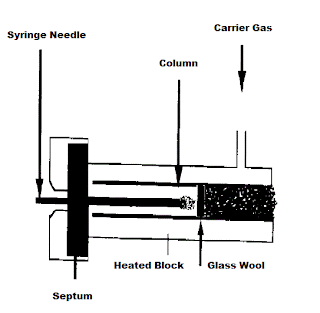Sample introduction techniques to a gas chromatographer have already been mentioned in a previous post entitled "What is gas chromatography?".
These techniques are the following:
- Splitless injection
- Split injection
- Temperature-programmed injection
- On-column sample injection
The splitless and split injection techniques have been described in the previous post given above and the main advantages and disadvantages have been mentioned.
Another sample introduction technique to a gas chromatographer is the temperature-programmed injection.
When the temperature-programmed injection technique is used?
This method is used for thermolabile samples and for samples which may form artifacts at high injector temperatures. Use of split/splitless injection may lead to artifact formation when thermolabile samples are analyzed.
The temperature-programmed injection technique is an alternative to the split/splitless injection. In this method of injection, the liquid sample is injected into a "cold" injector. The initial injection temperature is usually set at about 10 C below the boiling point of the sample solvent. After introduction of the sample, the injector is usually subjected to temperature-programmed heating up to 300 C in 20-30 seconds. Since evaporation of the solvent is likely to take place first in the initial temperature, it is feasible to vent most of the solvent through the split valve and then close the valve to pass the sample mixture (Fig. 1)
The advantage of this procedure is that the solvent can be removed by a time-controlled split before the actual separation takes place. Some say that sample discrimination problems are less and certainly the thermal shock to the sample is less severe.
Another sample introduction technique used is the so called on-column injection. In this method, the sample is injected directly onto the column. The syringe is pushed as far as it will go into the port and its contents are delivered into the first part of the column packing where a small glass wool plug exists (Fig. 2). Columns with a small inside diameter are unsuitable for this technique of sample introduction.
Another sample introduction technique used is the so called on-column injection. In this method, the sample is injected directly onto the column. The syringe is pushed as far as it will go into the port and its contents are delivered into the first part of the column packing where a small glass wool plug exists (Fig. 2). Columns with a small inside diameter are unsuitable for this technique of sample introduction.
When the on-column injection technique is used?
This method is suitable for polar and thermally unstable samples. Since the on-column injection is a splitless technique, only low-concentration samples can be used.
The main advantages of this technique are:
- "Cool" injection reduces thermal reactions and needle discrimination during injection
- Direct quantitation of the sample components
- Excellent precision
- There are the obvious mechanical considerations such as column/needle alignment and column and needle dimensional compatibility
- The injection must be made as fast as possible so that there is no sample discrimination
- Samples must be free of non-volatile materials
 |
| Fig. 2: Typical set-up for an on-column injection. |
References
- R.R. Freeman, "High Resolution Gas Chromatogaphy", Hewlett-Packard Co., 1981
- H.M. McNair, J. M. Miller, "Basic Gas Chromatography", John Wiley & Sons, 1998
- I.A. Fowlis, "Gas Chromatography", John Wiley & Sons, 1995

No comments:
Post a Comment